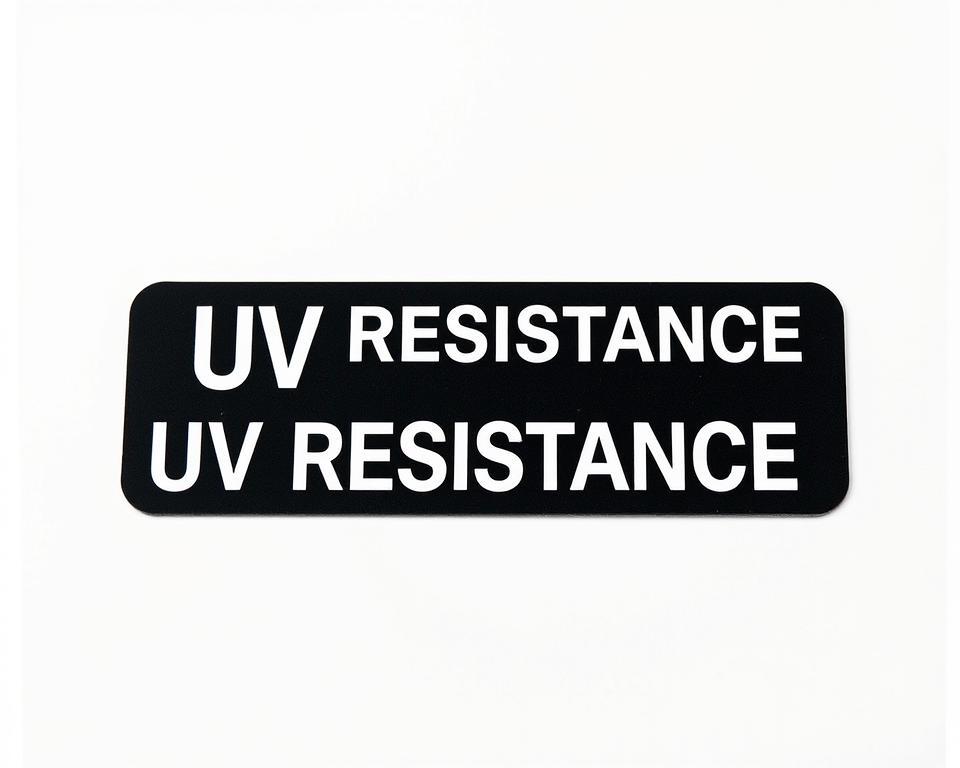I’ve seen how important durable protection is in many fields. This is true for equipment and surfaces that face harsh conditions.
Chemical resistance stickers are key in keeping these items safe. They protect against chemicals, scratches, and other damage.
I love finding long-lasting solutions. I’m happy to tell you about the good things these stickers do. They work well in many places.
We will talk about why chemical resistance stickers are so important. They offer strong protection.
Key Takeaways
- Understanding the role of chemical resistance stickers in industrial protection.
- Benefits of using durable stickers for equipment and surfaces.
- Applications of chemical resistance stickers in various industries.
- How to choose the right stickers for your needs.
- Best practices for applying chemical resistance stickers.
The Critical Role of Chemical Resistance Stickers in Safety
Chemical resistance stickers are very important for safety in many places. They can handle tough chemicals. This keeps important info clear and safe.
What Sets These Specialized Labels Apart
Chemical resistance labels are not like regular labels. They’re made to fight off harmful chemicals. This is key in places where chemicals are always around.
These labels last a long time. They keep safety info and rules clear. This lowers the chance of accidents.
The Science Behind Chemical Resistance Technology
The tech in chemical resistance stickers is cool. It uses special materials and ways to make them. These labels can stand up to many chemicals, like acids and oils.
Knowing how these labels work helps us see their value. It keeps our work places safe.
Why Your Facility Needs Chemical Resistance Labels
Chemical resistance labels are key for safety and following rules in places where chemicals are used. They can handle tough conditions. This keeps important info clear and safe.
Regulatory Compliance Requirements
Facilities need these labels to follow regulatory compliance requirements. Groups like OSHA and EPA say chemicals must be labeled right. Labels that can stand up to chemicals help avoid fines and penalties. Some important rules include:
- OSHA’s Hazard Communication Standard (HCS)
- EPA’s labeling rules for hazardous waste
- Following the Globally Harmonized System of Classification and Labeling of Chemicals (GHS)
Preventing Costly Accidents and Liability Issues
Chemical resistance labels also help avoid big accidents and legal problems. They make sure labels stay clear. This stops mistakes with chemicals, lowering accident risks and legal troubles. For example, a clear chemical storage area stops mix-ups that could cause harm.

Getting good labels for chemicals protects workers, stuff, and your place’s name. I say think about the long-term good of chemical resistance labels when picking labels for your place.
Key Features of My Chemical Resistance Stickers
I’ve made stickers that are great for places where chemicals are used. They are made with special care for these areas. This is because of the research I did to meet their needs.
Advanced Material Composition
My stickers are made from a special material. This material is good against many chemicals. It keeps the stickers looking good even when chemicals are around.
This material is picked for its top resistance. It’s perfect for labs, factories, and places where chemicals are a big worry.

Industrial-Grade Adhesive Technology
The glue on my stickers is very strong. It stays strong even when chemicals and stress are around. This industrial-grade adhesive technology makes the stickers stick well to many surfaces.
They stick to metals, plastics, and glass. And they keep sticking without losing their grip over time.
Fade-Resistant Printing Methods
I use special printing to keep the stickers clear. The inks I use don’t fade easily. This means the stickers stay readable for a long time.
They keep looking good even with chemicals, sunlight, and other things around. This makes sure the stickers are always clear and safe.
Types of Chemicals My Stickers Can Withstand
I’ve made stickers that can handle many chemicals. They keep your labels safe. My stickers protect against lots of substances.
Acids and Bases Resistance
My stickers are great against acids and bases. This is key in places where chemicals mix a lot.
Strong Acid Exposure Testing
My stickers faced strong acids like hydrochloric and sulfuric acid. They barely changed. Here’s what happened:
| Acid Type | Concentration | Sticker Condition After Exposure |
|---|---|---|
| Hydrochloric Acid | 30% | Intact, no visible damage |
| Sulfuric Acid | 50% | Minor discoloration, still legible |
Alkaline Solution Performance
My stickers also did well against alkaline solutions like sodium hydroxide. A top chemical engineer said,
“The durability of labels in alkaline environments is a significant challenge. These stickers show remarkable resilience.”
Solvents and Petroleum Products Protection
My stickers also protect against solvents and petroleum products. They’re perfect for industrial use. They don’t dissolve and stick well to surfaces.

Industrial Cleaners and Disinfectants Durability
My stickers can also handle industrial cleaners and disinfectants. Labels stay in place and clear after cleaning.
Overall, my stickers are a solid choice for labeling in many industries. They work well in harsh chemical environments.
Industries That Benefit From Labels for Chemicals
Chemical labels are very important in many places. They help keep people safe and make sure things work right. I’ve seen how they help in many areas.
Laboratory and Research Facilities
In labs, labels are key for knowing what chemicals are there. They warn about dangers and help keep track of things. Reliable labeling keeps labs safe and follows rules.
Manufacturing and Industrial Settings
Labels are also very useful in factories. They help find out what’s in pipes and equipment. I suggest using labels that can handle tough factory conditions.
Healthcare and Pharmaceutical Applications
In hospitals and pharmacies, labels are super important. They help keep patients safe and follow rules. Clear and durable labeling helps doctors and nurses do their jobs right.

| Industry | Label Use | Key Requirements |
|---|---|---|
| Laboratory and Research | Identifying substances, warning about hazards | Resistance to chemicals and extreme temperatures |
| Manufacturing and Industrial | Identifying pipes, equipment, hazardous materials | Durability, resistance to solvents and high temperatures |
| Healthcare and Pharmaceutical | Labeling medication, laboratory samples, cleaning supplies | Clarity, durability, compliance with healthcare regulations |
Customization Options for Stickers for Chemicals
I offer many ways to customize stickers for chemicals. This lets industries make labels that fit their needs. It makes labels work better and follow rules.
Size and Shape Variations
Stickers can be made in many sizes and shapes. This flexibility in design makes sure labels fit right. They also look good and are easy to see.
Strategic Color Coding Systems
Color coding is key for chemical labels. My stickers can have special colors. This helps tell different chemicals apart, making work safer and more efficient.
Text, Barcode, and Symbol Options
Stickers can also have custom text, barcodes, and symbols. You can add chemical names, hazard warnings, and handling instructions. Barcodes help with inventory, and symbols show important safety info fast.
| Customization Feature | Description | Benefit |
|---|---|---|
| Size and Shape | Varied dimensions and forms | Enhanced visibility and fit |
| Color Coding | Specific colors for differentiation | Improved safety and efficiency |
| Text, Barcode, and Symbols | Customizable content for information and tracking | Better compliance and inventory management |

Application Techniques for Maximum Adhesion and Longevity
Getting chemical labels stickers to stick well and last long needs the right steps. I know how important it is to make them last. So, I always teach the best ways to apply them.
Surface Preparation Guidelines
Before putting on chemical labels stickers, the surface must be ready. This means cleaning it well and making sure it’s free from dirt.
Cleaning Procedures
Thorough cleaning is key. Use a mild soap and water to get rid of dirt, oils, or other stuff that can mess with sticking.
Temperature Considerations
The surface and air temperature can change how well they stick. It’s best to apply them when it’s between 60°F to 80°F (15°C to 27°C). This helps them stick better.
Application Methods and Specialized Tools
Choosing the right way to apply and tools can make a big difference. I suggest using application tapes or transfer tapes for small labels. They help place them just right.

Temperature Resistance Properties of Chemical Labels Stickers
I’ve made chemical labels stickers that work well in many temperatures. They can handle cold and hot conditions. This is key for industries that work with chemicals in different environments.
My stickers stay strong and clear, keeping important safety info visible.
Cold Environment Performance (-40°F to 32°F)
In very cold places, my stickers stay flexible and whole. They can handle -40°F temperatures. This makes them great for cold storage or outside in the cold.
The glue sticks well, so the labels stay put.
Heat Resistance Capabilities (Up to 300°F)
My stickers can also handle high heat, up to 300°F. This is important for places where things get very hot. The labels stick well and show clear info even in extreme heat.

UV and Weather Resistance Characteristics
My chemical resistance labels can handle tough weather and UV rays. They work well indoors and outdoors where safety labels are key.

Outdoor Application Considerations
Outdoors, my labels face sun, rain, and hot or cold weather. The UV resistance of these labels keeps them clear and strong. This is crucial for places that keep chemicals outside, where labels must stay safe and clear.
Expected Lifespan in Various Environmental Conditions
My labels last a long time, even in bad weather. The advanced materials used make them tough. This means less need to replace labels often, keeping places safe and following rules.
How My Chemical Resistance Stickers Outperform Standard Options
My chemical resistance stickers stay strong in places where regular labels fail. This is key in places where chemicals are used a lot.
These stickers are made with special materials and methods. This makes them better than regular labels in many ways.
Comprehensive Cost-Benefit Analysis
Looking at the cost of my stickers and regular labels, we see a big difference. Regular labels might cost less at first. But they need to be replaced more often because they can’t handle tough conditions.
My stickers cost a bit more at first. But they last longer and can handle chemicals better. This means they save money in the long run.
| Label Type | Initial Cost | Replacement Frequency | Total Cost Over 5 Years |
|---|---|---|---|
| Standard Labels | $100 | 4 times | $500 |
| Chemical Resistance Stickers | $250 | 1 time | $250 |
Performance Comparison in Extreme Conditions
In very tough conditions, like high heat or strong chemicals, my stickers do better than regular labels.
They stay strong even when chemicals are around a lot. This means labels stay clear and don’t fall apart.

Long-Term Value and Return on Investment
My stickers save money over time because they last longer and work better. This makes them a smart choice for saving money.
Places that use my stickers have fewer problems with labels. This can help avoid accidents or problems with following rules.
In short, even though my stickers cost more at first, they are worth it. They last longer and work better, saving money in the long run.
Real-World Success Stories and Applications
My labels for chemicals have made a big difference in real life. I’ve worked with many industries, and the results are always great.
Laboratory Environment Case Study
In labs, it’s very important to label things right. A research facility used my labels and saw fewer mistakes. The resistant material and clear printing helped labels stay clear even after being exposed to chemicals.
- Improved safety through accurate labeling
- Reduced errors due to chemical resistance
- Enhanced compliance with regulatory requirements

Industrial Manufacturing Implementation Example
In industrial settings, my labels are tough and dependable. A plant used them to mark chemical storage, and they lasted through tough conditions. This included very hot or cold temperatures and being near solvents.
This worked well because it saved money and made things run smoother. The labels stayed strong, keeping safety info ready to go.
Conclusion: Investing in Quality Protection for Your Chemical Labeling Needs
Reliable chemical labeling is key for your facility’s safety and rules. High-quality chemical resistance labels keep your labels clear and strong, even in tough places.
Choosing durable labels is a big decision. It affects your work and money. Chemical resistance labels stop expensive accidents and keep you safe from legal trouble.
My chemical resistance stickers last a long time and protect your labels well. Pick the right labels for your job to get lasting quality and safety.
For chemical labeling, always choose quality protection. This keeps your work safe and efficient. You can count on your labels to work well, even in hard places.
FAQ Chemical Resistance Labels
What are chemical resistance labels made of?
Can I customize the size and shape of chemical resistance stickers?
How do I apply chemical labels stickers for maximum adhesion?
Are your chemical resistance labels suitable for outdoor use?
Can your labels withstand extreme temperatures?
How long do chemical resistance stickers last?
Do you offer color coding options for chemical labels stickers?
Can I include text, barcodes, and symbols on the labels?
Are your chemical resistance labels compliant with regulatory requirements?
Yes, my chemical resistance labels follow all the rules for chemical labeling. I make sure they meet all the standards and regulations.
Contact Details:
Address:
ANANDHA PRINT SOLUTIONS PVT LTD
32/2, First Floor,
Sathanipet 2nd Street,
Adj. Five Furlong Road,
Maduvinkarai, Guindy,
Chennai, Tamil Nadu,
India- 600 032.
Phone:
+91 98409 64267
Email:
info@aprints.in
sales@aprints.in
admin@aprints.in
accounts@aprints.in
design@aprints.in
Geo – Domestic State Supplies
Andhra Pradesh | Arunachal Pradesh | Assam | Bihar | Chhattisgarh | Goa | Gujarat | Haryana | Himachal Pradesh | Jharkhand | Karnataka | Kerala | Madhya Pradesh | Maharashtra | Manipur | Meghalaya | Mizoram | Nagaland | Odisha | Punjab | Rajasthan | Sikkim | Tamil Nadu | Telangana | Tripura | Uttarakhand | Uttar Pradesh | West Bengal
Geo – Domestic City Supplies
Chennai | Mumbai | Kolkatta | Delhi | Bengaluru | Hyderabad | Coimbatore | Thirchy | Madurai| Salem | Erode | Kanyakumari | Thanjavur | Tirunelveli | Vellore | Tiruppur | Kochi | Thiruvananthapuram | Kozhikode | Thrissur | Kollam | Tumkur | Mangalore | Mysore | Udupi | | Davangere | Dharwad | Hubli | Belgaum | Chitradurga | Karwar | Batkal | Visakhapatnam | Vijayawada | Nellore | Sri City (Tada) | Rajahmundry | Ongole | Tirupathi | Kakinada | Amaravathi | Guntur | Anantapur | Kadappa | Ahmedabad | Surat | Vadodra | Rajkot | Bhavnagar | Jamnagar | Jaipur | Jodhpur | Udaipur | Ajmer
International Supplies
Asia- Malaysia | Singapore | Japan | Korea | Thailand | Myanmar | Indonesia | Vietnam | Cambodia | SAARC- Srilanka | Bangladesh | Nepal | Bhutan | Afghanistan | Africa- Algeria | Ethiopia | Ghana | Nigeria | Uganda | Kenya | Tanzania | Uganda | Zambia | Zimbabwe | Egypt | Middle East- UAE | Kuwait | Qatar | Oman | Kingdom of Saudi Arabia | Bahrain | Jordan | Europe- United Kingdom | Germany | France | Switzerland | Italy | Spain | Portugal | Norway | America– United States Of – America | Canada | Mexico | Brazil | Argentina | Greenland | Other Countries – Russia | Australia







